Description of the apple tree Gloucester
Apple Gloucester is one of the most common European varieties. His country of origin is Germany. It appeared in 1951 as a hybrid of Richard Delicious and Glockenapfel. More than 20 years ago, it passed successful acclimatization in Ukraine, then came to the southern regions of Russia and Belarus. Now grown in private and industrial gardens.
- Characteristics of the variety
- Description of the tree and fruit
- Useful properties and calorie content
- Taste
- Yield
- Pollinators
- Winter hardiness
- Diseases and pests
- In which regions is it better to grow
- Landing
- Landing dates
- Selection of seedlings
- Landing scheme
- Care
- Watering
- Top dressing
- Pruning and shaping the crown
- Diseases and pests
- Features of ripening and fruiting
- Harvesting and storage
- Subspecies and variants
- Growing on a dwarf rootstock
- Growing on a columnar rootstock
- Gardeners' reviews about this variety
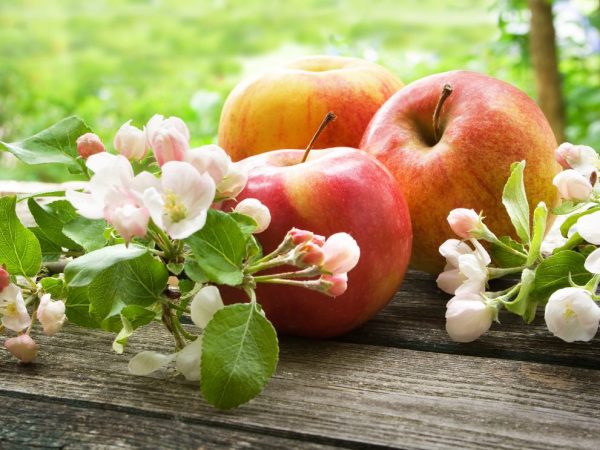
Description of the apple tree Gloucester
Characteristics of the variety
The Gloucester apple variety has spread to different countries over the decades of its existence. It is grown commercially for its good taste, long distance transport, and long shelf life.
Description of the tree and fruit
The apple tree is tall, reaching 8-8.5 m in height. The crown of young seedlings is pyramidal, rounded over time, its diameter is 3-3.5 m and medium thickening. Branches grow at an angle of 45–55⁰ with respect to the main trunk. The ability to form shoots in the variety is below average. The shape and density of the crown practically does not require correction.
Flowering begins in the middle or in the third decade of May and lasts 12-15 days. The inflorescences consist of 3-4 medium-sized buds. The type of fruiting is mixed, the ovaries develop on ringlets, twigs, fruit twigs, spears.
Description of fruits:
- Round or slightly tapered in shape.
- Ribbing is expressed in the lower part.
- The size is large, weight 140-180 g (sometimes up to 200-230 g).
- The main tone is yellow, the blush is crimson red (covers most of the surface).
- The skin is smooth, with a glossy sheen, medium in thickness and with good elasticity.
- Light dots are visible under the peel.
- The calyx is closed, deep and wide, with pronounced folded walls.
- The sub-cup tube resembles a cone, medium in length.
- The funnel can be of any depth and width.
- The stalks are medium, but sometimes thin or elongated.
- The pulp is light green when harvested, then turns creamy.
Useful properties and calorie content
Gloucester apples contain many vitamins and minerals. They include:
- Iron
- Sodium
- Calcium
- Potassium
- Magnesium
- Zinc
- Vitamin C
- B vitamins
- Carotene
- Vitamin E
The calorie content of the fruit is 48 kcal. The main part is water, so they can be eaten while on a diet. The high iron content, especially in the peel, helps to raise the level of hemoglobin. Apples are good for anemia. Fiber regulates the digestive tract.
Vitamins boost immunity. Since Gloucester can be stored until spring, it helps fight vitamin deficiency during this period. The potassium in the composition is good for the heart.
Eat with caution in case of acute gastritis, colitis, ulcers and allergies to red fruits.
Taste
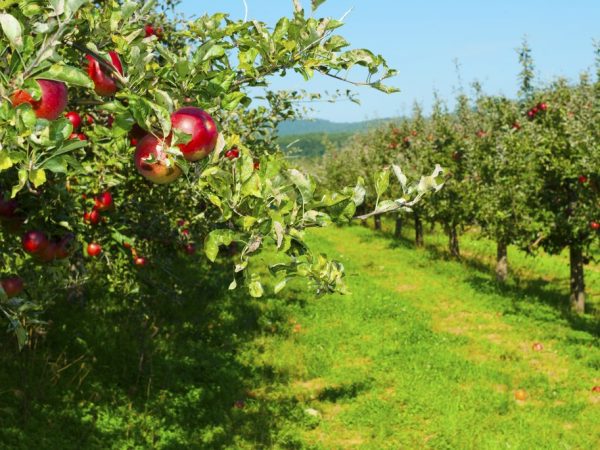
The fruits are delicious fresh
The flesh of Gloucester apples is juicy and firm. Even during storage, it does not become loose and retains liquid. The taste of the fruit is refreshing, sweet-sour, dessert.
Most often, apples are consumed fresh. They are also used to make juices, compotes, baby food puree and apple wine. They are suitable for cakes, rolls and other baked goods.
Yield
Since Gloucester was bred for industrial cultivation, special attention was paid to its yield.
The peak of fruiting occurs at 10-12 years of age. During this period, from 35 kg to 70 kg of fruits are harvested from the tree. 4-6 kg of products are obtained from dwarf apple trees.
You can increase the indicators by planting pollinators, proper care and fertilization.
Pollinators
Apple trees are bisexual. The flower contains both stamens and pistils. But it happened so evolutionarily that the possibility of fertilization of the ovary with pollen from the same tree is impossible or limited. They are propagated vegetatively.
Self-pollination is quite high. Ovaries are formed from 12-18% of flowers, and pollen viability is 35-80%. But in the presence of pollinators, the yield increases, ovaries can be obtained at 22-28%.
Top pollinators:
- Idared
- Gala
- Spartan
- Renet Simirenko
- Golden Delicious
- Super Chief
- Jonathan
- Champion
- James Grieve
- Empire
In addition, Gloucester itself can act as a pollinator for these varieties. To increase yields for 10-12 trees, you need to plant 1 pollinator. You can grow 2-3 varieties in the garden, planting alternately in 1-2 rows.
Winter hardiness
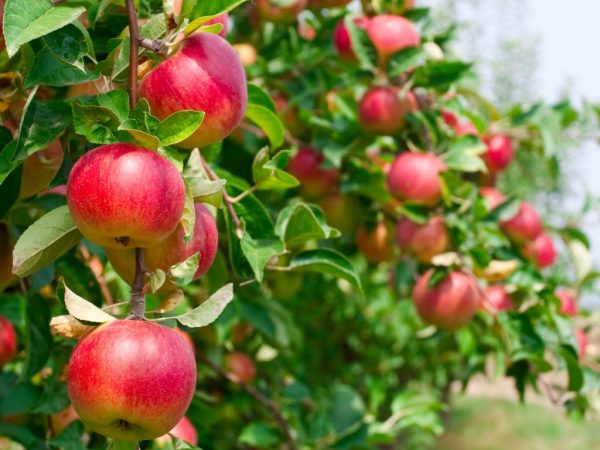
You can get a good harvest of apples in the southern lane
The winter hardiness of the variety is considered satisfactory: it can survive temperatures up to -35⁰С. But young shoots sometimes freeze under such conditions.
Saplings in the middle lane are recommended to cover for the winter.
The apple tree blooms in the 20th of May, when frosts are already rare. Therefore, the harvest is obtained on a regular basis in all regions. But for sale and industrial processing, the variety is more often grown in the southern regions, where more suitable soils and productivity are higher.
Diseases and pests
Gloucester is practically insensitive to powdery mildew. More often it is struck by scab. It appears as brown or olive spots on young leaves and ripening fruits. The disease is caused by a fungus that actively reproduces in fallen leaves.
In which regions is it better to grow
Gloucester made its first adaptation in Eastern Europe in the steppe and forest-steppe zones of Ukraine, as well as in Polesie. In Russia, it best of all took root in the Kuban, in the Stavropol Territory. But it is also well suited for the Moscow region and even Siberia.
In the northern regions, it is recommended to insulate the crown for the winter. The roots are covered with a layer of humus. In the Moscow region, adult trees do not need insulation. But young seedlings, up to 2-3 years old, should preferably be covered.
Landing
The beginning of fruiting and further yield largely depends on the correct and successful planting.
Landing dates
Gloucester can be planted in both spring and autumn. In the first case, there is less risk that the seedling will freeze in winter. This is especially true for the northern regions. When planting in autumn, a young tree manages to get stronger before spring and grows faster in summer.
In autumn, apple trees are planted from early to mid-October, in the southern regions - until early November.
Spring planting begins at the end of March, when the snow melts and the ground thaws. In the north, such a moment can come only by mid-April. For spring planting, the pit should be prepared in the fall.
Selection of seedlings
It is best to buy seedlings from specialized stores or farms. They are often brought from abroad. But the quality of domestic products is now no worse than that of imported ones.
You need to choose those that are not more than 2 years old, older specimens do not take root well. On a two-year-old, there are no more than 2-3 branches.
The trunk of a young tree is light green.It should be free of damage and defects, distortions. Examine the roots carefully: they should be intact, with no signs of rot. Better to buy fresh material, with remnants of moist soil.
Landing scheme
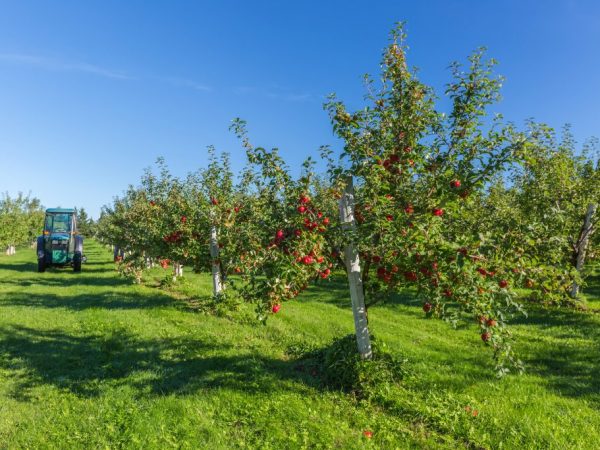
Trees need space
For trees, choose a spacious place that is not blown by the winds.
It is best if there is fertile soil on the site, admixtures of clay or loam are permissible. Gloucester does not like acidic soils and excess moisture.
A hole is dug to a depth of 60-70 cm and with a diameter of 90-100 cm.The distance between the two trees should be approximately 5 m.The upper 15-18 cm of soil is used as a substrate, which is mixed with the following fertilizers:
- Humus or compost - 35-45 l
- Superphosphate - 100-120 g
- Potassium sulfate - 55-75 g
Instead of minerals, you can take 3 liters of ash. All components are mixed and poured back into the pit. After a month, you can plant an apple tree there.
If there is sandy soil in the garden, it is recommended to fill the hole in layers with the following components:
- Clay - 10 cm
- Peat - 15 cm
- A mixture of soil with fertilizers - until the pit is completely filled
When planting, part of the prepared soil with fertilizers is removed from the pit. The roots of the seedling are straightened, broken or too long roots are removed. The tree descends into the hole strictly vertically. It is covered with earth so that the root collar is located 2-3 cm above its surface. The soil is slightly trampled, 2-3 liters of water are poured under the tree.
Care
The apple trees of Gloucester are well cared for and produce bountiful harvests. The products can be used not only for home consumption, but also for sale.
Watering
The first time the tree is watered in the spring, as soon as the buds begin to bloom.
The second is 20 days after the flowers have fallen off.
The third is 2 weeks before the start of the harvest. If the fall is dry, you can water the apple tree again in mid-October. This will protect its roots from freezing.
Amount of water for one irrigation:
- Young seedling 1-3 years old - 2-3 buckets
- Tree 3-5 years old - 5-8 buckets
- Wood 6-10 years old - 12-15 buckets
Top dressing
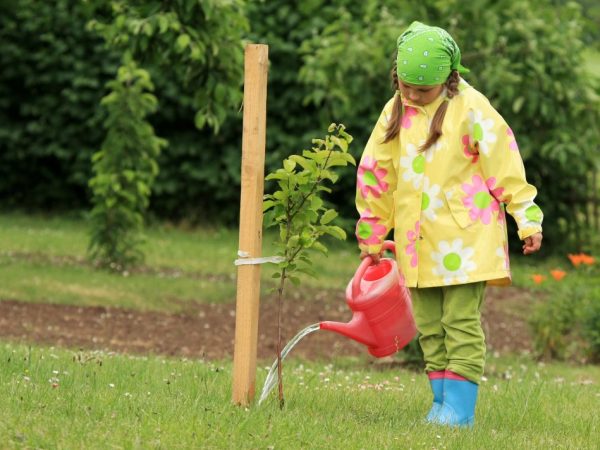
Fertilizers increase apple yield
Fertilization is a prerequisite for growing apple trees. They stimulate growth and increase yields. The first time fertilization is applied one year after planting. The following mixture is recommended:
- Urea - 0.5 kg
- Nitrofoska - 40 g
- Ammonium nitrate - 40 g
- Humus - 5 kg
The same mixture, rich in nitrogen, is then fed to apple trees every spring.
During the flowering period, trees need potassium and phosphorus. Top dressing with the following composition is recommended:
- Superphosphate - 100 g
- Potassium sulfate - 70 g
- Urea - 300 g
- Infusion of chicken manure - 2 buckets
- Slurry - 5 l
The third time the trees are sprayed with fertilizers. This is done when the fruits begin to form. The following composition is used:
- Nitrofoska - 50 g
- Sodium gummate - 1 g
From mid-June to the end of August, nitrogen and potassium-phosphorus fertilizers are applied twice a month. After harvesting, just before wintering, you need to dig up the soil, add compost or humus with complex fertilizing for fruit trees.
Pruning and shaping the crown
Pruning helps to form the crown, increase yields and prevent many diseases. In spring and autumn, they carefully examine the apple tree, remove dry and frozen branches. This is called sanitary pruning.
The crown begins to form from the first year. The best option for Gloucester apple trees is a sparse-tiered one. In the first year, the top of the tree is cut, thereby shortening the stem.
In the second year, 5 branches should remain - they will be the basis of the first tier. On the third, a second tier of 4 branches is formed. On the fourth - the third tier of three pagons.
The distance between the first and second tiers is 80 cm, between the second and third tiers is 40 cm. The crown is corrected up to 8-10 years of life of the apple tree. Then only sanitary pruning is carried out, in which about 30% of the shoots are removed.
Diseases and pests
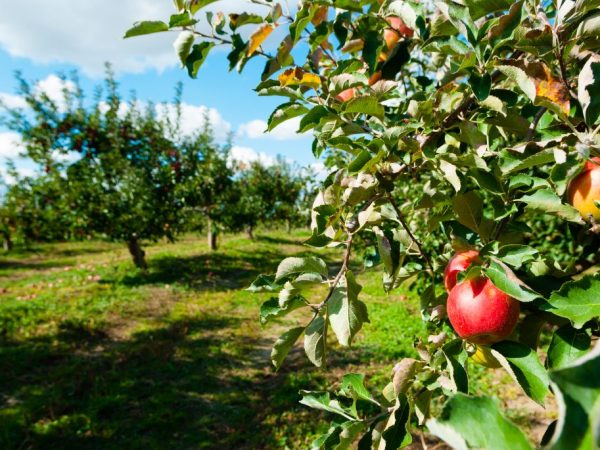
The variety is prone to scab disease.
Apple tree Gloucester is prone to fungal disease - scab. The pathogen multiplies in litter, affects foliage and fruits. Brown dots appear on them, apples become smaller, in severe cases a tree may die.
For prevention, in early spring and autumn, apple trees are treated with 1% Bordeaux liquid. Phytosporin is used in summer.
They are also treated with a solution of salt (1 kg / 10 l), soda (150 kg / 10 l), infusion of horsetail roots (2.5-3 kg / 10 l, rhizomes are finely cut and poured with water for 3-4 days), ash infusion (mix one liter of ash and water, insist 1-2 days). In the fall, fallen leaves must be removed.
Also, the apple trees of Gloucester can be affected by pests - aphids, apple cider mites, lice, penny, green cicada, scale insect, codling moth.
To combat them, the garden is treated with insecticides (Karbaphos, Nitrafen). From folk methods used infusions of tobacco, garlic, soapy water. Some plants repel insect pests - wormwood, marigolds, nasturtiums, calendula. They are recommended to be planted in the garden near apple trees.
Features of ripening and fruiting
The first harvest from the Gloucester apple tree can be harvested 4-5 years after planting. The maximum productivity of an adult tree is observed at 10-12 years. Fruiting is regular and stable. Since the cultivar blooms late, frosts rarely affect the buds. Fruits practically do not crumble if the tree is healthy.
Unripe fruits are green. From the beginning of autumn, the peel begins to turn yellow and become covered with a carmine-red hue, the fruits increase in size. At this time, you may need a support for the branches. It is made for young trees and in years when the harvest is especially plentiful.
In the last days of September, the apples are fully ripe and turn yellow-red. The pulp remains greenish-green, plump.
The taste is most pronounced in late December and early January, because the variety is classified as winter, intended for long-term storage.
Harvesting and storage
Harvesting begins at the end of September and continues until mid-October. Apples stick well to the branches, only a few pieces fall off. But this does not mean that you need to delay the start of cleaning.
The fruits should be plucked from the tree on a dry sunny day, closer to lunchtime, so that the dew dries on the peel. Wet storage is worse.
The collection is carried out exclusively by hand. The fruit is plucked carefully, breaking off the stalk so as not to damage it. Then they are put in boxes. For better storage, the layers can be sprinkled with wood shavings, sawdust or straw.
It is advisable that the fruits do not come into contact with each other. Then there is less chance that rot from one will spread to the whole box.
It can be stored in a basement at a temperature of 4-7⁰C and a humidity of 65-75%. Be sure to provide high-quality ventilation in this place. Small quantities can be stored directly in the refrigerator on the bottom shelf.
Gloucester apples improve their taste over time. Until February, they are stored practically without loss. They can stay in the refrigerator even until the beginning of May.
Subspecies and variants
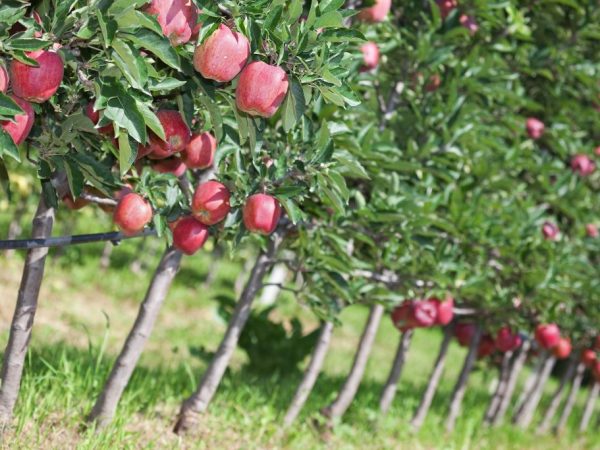
Low-growing subspecies are easier to care for
The Gloucester apple variety can be grown not only from a ready-made seedling, but also from a stock.
Growing on a dwarf rootstock
The height of an apple tree on a dwarf rootstock is 2.5 m, and the width of the crown is up to 3 m. Its yield is slightly higher, and fruiting begins earlier, already by 2-3 years.
The variety is resistant to late spring frosts. Gathering apples, pruning on a low-growing tree is more convenient than on a tall one.
The disadvantage is the high location of the roots in the ground. Therefore, it needs to be watered regularly, covered with mulch for the winter to protect it from frost. But you can plant it even with a high standing of groundwater without fear of decay of the root system.
Growing on a columnar rootstock
Column stock is also a low tree (about 2 m), with a crown extended upwards. The diameter of the apex is very small, up to 1.5-2 m.This saves a lot of space in the garden. Grafting on the rootstock takes root well, fruiting begins the next year. The yield is stable and high.
So that the trees grow well and do not bend, they are provided with support. The tapestries have a very beautiful look and become a real decoration of the garden.
The disadvantage of the stock is a short fruiting period. After 15 years, the yield drops sharply and the trees need to be replaced. We must not forget that the bark is soft and juicy and attracts rodents. Therefore, in the winter, it must be protected.
Gardeners' reviews about this variety
Most gardeners' reviews of Gloucester are positive. Many answer the beautiful decorative appearance of apples, their keeping quality.
In late winter and early spring, when most fruits have lost their quality or deteriorate, Gloucester fruits remain juicy and sweet. Farmers who grow them for sale try to keep the fruits until February or March to get more income.
The trees on the rootstock take up little space in the garden, so they can be planted even in a limited area. They have a relatively high winter hardiness. Gardeners from the middle lane and northern regions bring seedlings from the south and successfully adapt them on their plots. The bark is sensitive to sunburn, so it is recommended to treat it with lime or special compounds.
The Gloucester apple variety is tasty and popular in many European countries. It adapts well to any climatic conditions, does not require much space in the garden and does not require special care. It can even grow on clay or sandy soils, after correct fertilization.
Apples are stored until the end of April, so they will be an excellent vitamin supplement to the diet in early spring.

